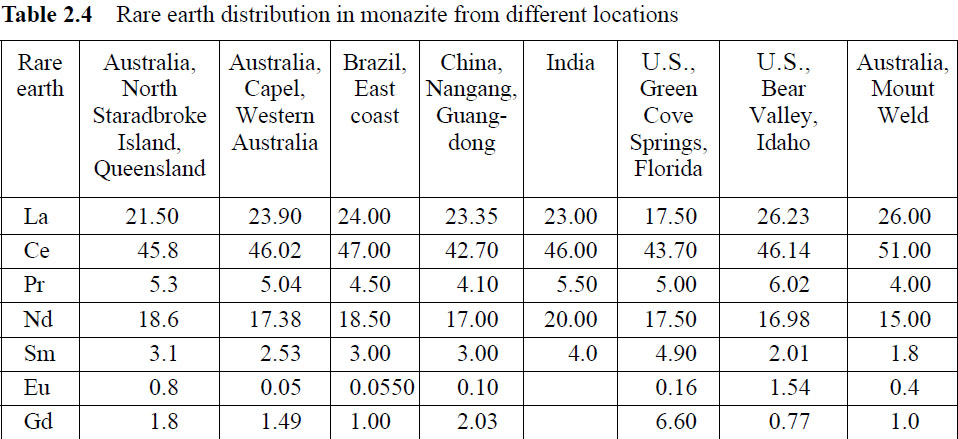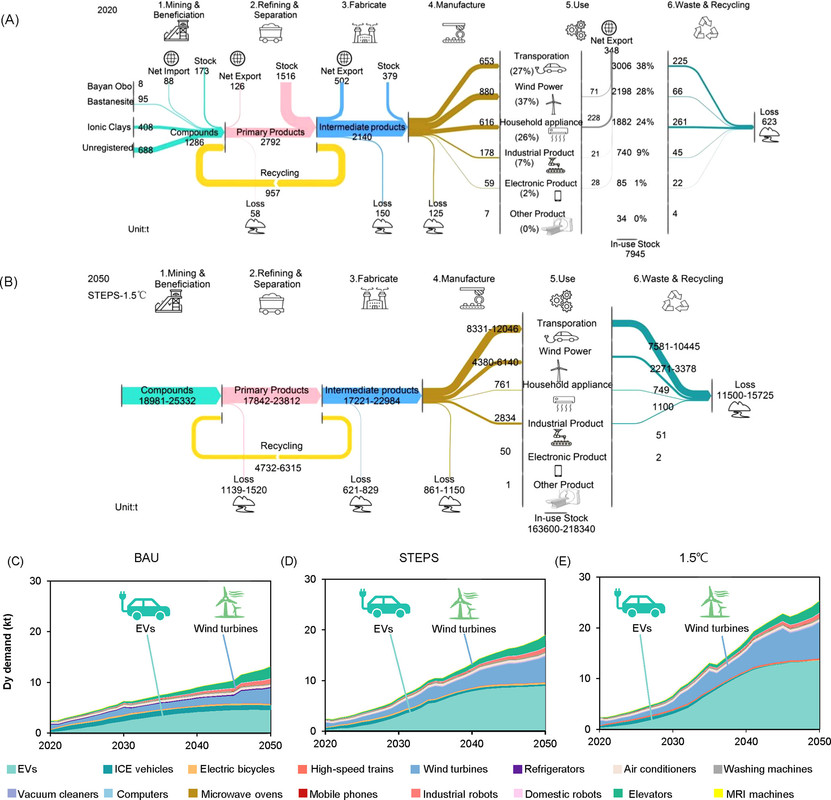Science
Related: About this forumUnlocking Dysprosium Constraints for China's 1.5 C Climate Target
Last edited Sat Nov 25, 2023, 12:27 AM - Edit history (1)
The paper to which I'll briefly refer in this post is this one: Unlocking Dysprosium Constraints for China’s 1.5 °C Climate Target Tao Dai, Yan-Fei Liu, Peng Wang, Yang Qiu, Nabeel Mancheri, Wei Chen, Jun-Xi Liu, Wei-Qiang Chen, Heming Wang, and An-Jian Wang Environmental Science & Technology 2023 57 (38), 14113-14126.
The paper is open to the public, albeit in a scientific journal and can be read in its entirety by anyone who is interested in its contents, but perhaps some excerpts are in order.
First a little about dysprosium, the subject of the article. Dysprosium is element 66 in the periodic table and is a member of the lanthanide (4f) series of elements, 14 elements running from lanthanum to lutetium. They are sometimes called - I personally avoid the term - the "Rare Earth Elements" although, as is often pointed out, many of the elements in the series are not particularly "rare," although some are. The lanthanides can be divided into two parts, roughly, based loosely on their chemistry, the "light fraction" running from lanthanum to europium, with europium having some chemical properties at variance with the rest of the group, and the "heavy fraction," from gadolinium to lutetium. Dysprosium is a member of the "heavy fraction." The members of the heavy fraction are less common than those of the light fraction; this may be a function that the light fraction consists of fission products that may resulted from the fission of heavy actinides formed in the stellar R process, or it may not. It's just my speculation. The heavy fraction, by contrast, must be a function of the s process in stellar bodies where the heavy elements are formed.
As a constituent of the main ores for the lanthanides, bastnasite and monazanite, and dysprosium is not particularly plentiful as when compared to the main components of the ores as shown in the tables below:


Ref: Volker Zepf, Rare Earth Elements, A New Approach to the Nexus of Supply, Demand and Use: Exemplified along the Use of Neodymium in Permanent Magnets, Springer 2013 pp (University of Augsberg Thesis), Ch. 2.
As one moves from the light to the heavy lanthanides, their melting points increase, lutetium's melting point is 1925 Kelvin, whereas 1193 Kelvin. The melting point of dysprosium is 1680 Kelvin.
Most modern magnets, since the 1980's, are based on lanthanides, beginning with samarium/cobalt magnets, now largely supplanted by neodymium-iron-boride (NdFeB) magnets. In order to maintain the magnetization of NdFeB magnets, taking advantage of dysprosium's relatively higher melting point which contributes to its "coercivity," its resistance to demagnetization by the temperatures generated in the magnet as its field interacts with the induced field of the generator coils, about 6% of the neodymium is substituted by dysprosium. This is true in generators and in electric motors.
Because of the importance of magnets in the conversion of mechanical energy into electrical energy and electrical energy to mechanical energy, dysprosium has become a critical metal.
From the text of the paper:
(For all this talk about a putative "low carbon transition" as if it were underway, it is nonetheless nonsense. We are using more fossil fuels than every and the percentage of the world's primary energy dependent on fossil fuels is rising, not falling. We can lie, to each other and to ourselves, but numbers don't lie. The 2023 World Energy Outlook will come out at the end of this month, and having followed these for decades, I can guarantee the numbers won't be pretty; they never are, not that this has any effect on the volume and frequency of appeals to wishful thinking and soothsaying.)
The paper continues:
In this study, we examine China’s Dy demand and supply associated with NdFeBs demand during 2021–2050 with three climate scenarios (the business-as-usual scenario (BAU), the stated policies scenario (STEPS), and the 1.5 °C scenario (1.5 °C), with details in Methods part) by integrating the history of the Dy cycle through material flow analysis during 2001–2020 (Figure 1). In particular, we provide a comprehensive projection of Dy demand in all expected NdFeB applications with a coverage of different phases of Dy supply chain from mining, refinery, trade, throughout to final recycling. Our results indicate that there will be a rising Dy supply shortage that may hinder China’s 1.5 °C climate target...
This calls for a corrective note based, again, on numbers, which don't lie. There is no evidence, none, that the growth of the wind industry all over this planet at a cost of trillions of dollars and the industrialization of vast stretches of land, much of it former wilderness, has done anything at all to address climate change. The rise of the wind industry has in fact correlated strongly with an acceleration of the rate of climate change and an acceleration of the rate of accumulation of the dangerous fossil fuel waste carbon dioxide in the planetary atmosphere. Trillion dollar quantities of money have been squandered on wind for no environmental result other than the industrialization of once virgin land.
Nevertheless, the world continues, in spite of all evidence, to act as if the wind industry is somehow involved with addressing climate change. It isn't. Because it is unreliable and unpredictable over long time scales, the wind industry is wholly and totally dependent on access to fossil fuels, since fossil fuels, while unacceptably and dangerously dirty, are reliable.
From the paper, a Sankey diagram of dysprosium flows:

The caption:
From the paper's conclusion:
I added the bold.
Note that this text refers only to China, which is the world's largest supplier of lanthanides, and not to the rest of the planet.
When the wind isn't blowing, all the dysprosium in a wind turbine is a stranded asset. If a dangerous fossil fuel plant is required to back up the wind industry during these periods and shuts because the wind is blowing, when the wind blows the dangerous fossil fuel plant is a stranded asset. This is an economic and an environmental cost of redundancy, all the delusional bullshit about batteries and worse, hydrogen not withstanding. (Note that the second and worst form of energy storage mentioned, hydrogen, also requires redundant Nd/Fe/B/Dy magnets.)
It follows, that if mechanical energy is to be converted to electrical energy, the limits of sustainability will be a function of reliability. There is one, and only one, form of energy that is reliable, clean, and essentially infinitely expandable, nuclear energy.
Have a nice weekend.